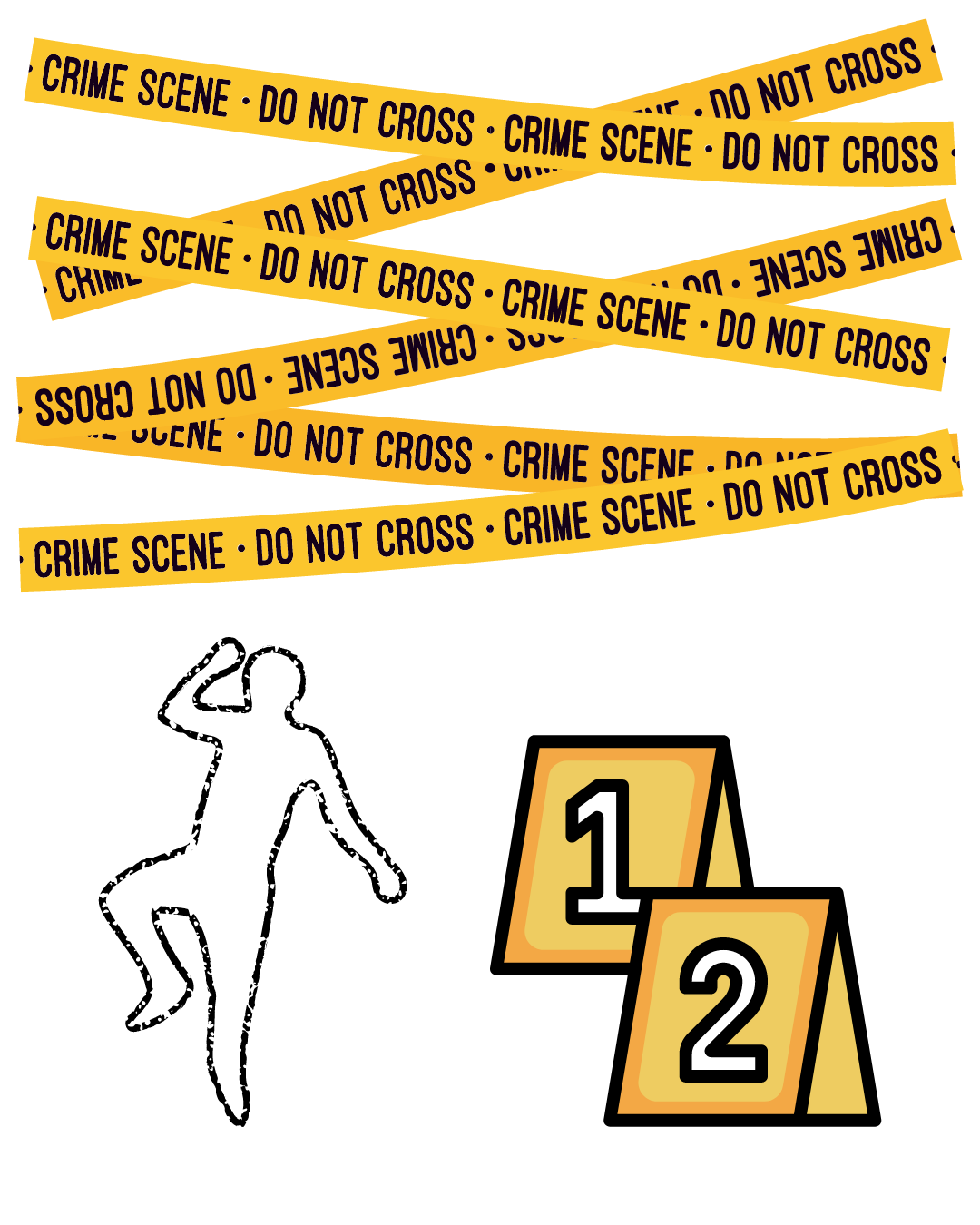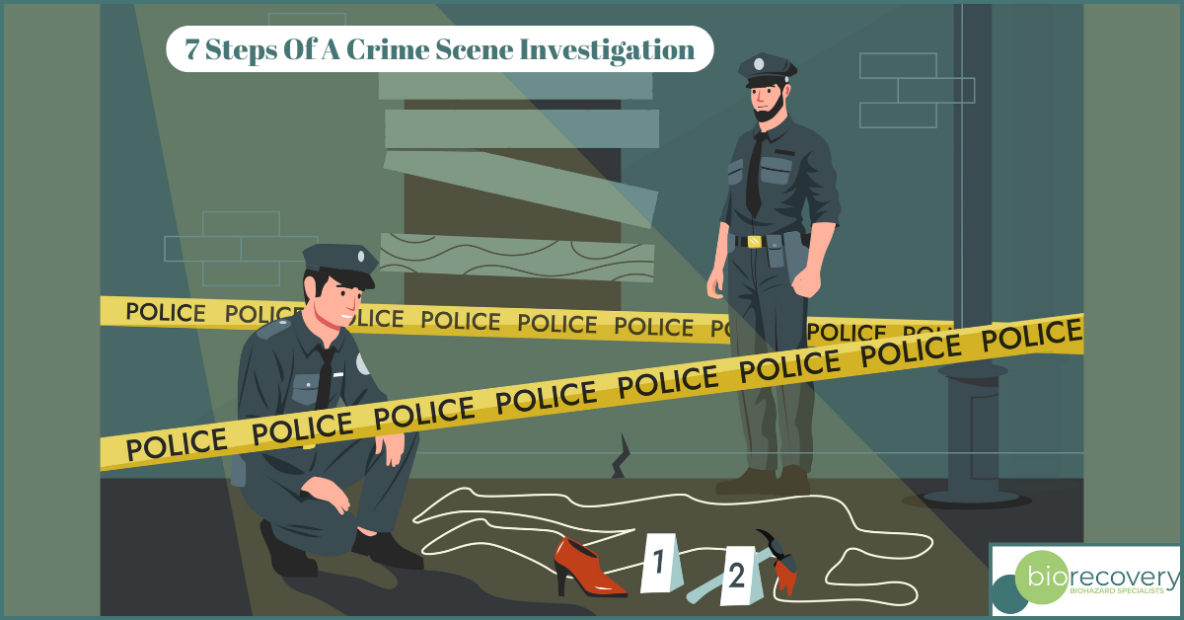We can’t help but admire those that play a role in crime scene investigation. As cleaners, we’re also fascinated by forensic technology and prowess used to analyze a crime scene. We’d like to highlight the intriguing process and understated methods forensics use to comb through evidence and catch a criminal.
It’s not as easy as it looks. Most scenes are messy, complex, and confusing. To the common eye and many novice investigators alike, there are more questions than answers. For privacy and simplicity, we’ve reconstructed a fake crime scene to analyze the 7 steps of a crime scene investigation.
Mock Study: The Investigation of Katie Perris
At around midnight, Mary Smith, 56, calls the local precinct, unsettled by a few days of no contact by 36-year-old daughter Katie Perris. Police are the first to arrive at the scene and notice the door lock had been noticeably tampered with.
After receiving no response, the police entered the residence and noticed an unusual smell emanating. The smell leads them into the bedroom, where they find Katie’s bloody body strewn on the bed and the floor. It appears she had died from a gunshot wound.
Upon discovery, the police call in:
- Forensic scientists and analysts
- Detectives
- EMS
- Coroner
- Medical examiner
These are the teams expected to be present to work with the evidence quickly before the environment takes over.
7 Steps Of A Crime Scene Investigation
These are the typical 7 steps of a crime scene investigation.
Step #1: Establish The Scene Dimensions And Isolate The Area
The police are usually the first to arrive at a crime scene, but when multiple units are called, it could be another specialized crime unit. The first trained professional at the scene is expected to secure and isolate the area as quickly as possible by setting a starting and focus point. In this example, the starting point would be the bed and surrounding floor inside Katie’s bedroom.
As cleaners, a scene can't really be isolated, as biomatter spreads everywhere. During a cleanup, every potentially contaminated area counts. Investigators working on a crime scene reconstruction need to be more focused, however. (Imagine an amateur working on this crime scene!)
Step #2: Establish Security
Establishing security at a crime scene is of paramount importance. According to Locard's Exchange Principle, every person who enters or exits the scene will add or subtract material. To avoid any contamination with evidence it is crucial to control access to the scene.
A common entryway must be established that all crime scene personnel will use to enter and exit. There should also be documentation of all people entering or leaving the scene. Additional areas for consultation and evidence storage may also be created to maintain the integrity of the investigation.
Step #3: Coordinate Teams and Plan
Once the entry and exit points are established the teams do a step by step investigation to reconstruct what may have happened.
In this case, the police initially speculated the perpetrator was an abusive ex boyfriend or friend of Katie’s that had broken into her home. The areas appeared clean and undisturbed, leading police to think the perpetrator only attacked her in the bedroom.
This changed after a forensic analyst noticed a small 6mm dried speck on the kitchen molding, about 3 feet from the front door. Now the speck of blood is a part of additional evidence suggesting the struggle started before the bedroom. (Again, imagine someone inexperienced trying to assess or clean this scene up)

Key Points
In this simple example, multiple crime scene units work together to process and analyze the crime scene.
Step #4: Primary Survey/Walkthrough
This is when preliminary research will be done on site to prioritize evidence collection. During this step, the lead investigator will identify potentially valuable evidence, take notes and take preliminary photographs of the scene and evidence. A documented record of conditions such as lights on or off, position of curtains and doors, position of movable furniture, odors, scene temperature, etc. to facilitate this.
Step #5: Documenting a Crime Scene
Crime scene investigators commonly document a crime scene by taking photos, videos, notes, and even sketching the scene. Modern technology has paved the way for detailed 3D laser scanners as well.
Analysts and detectives would document Katie Perris' case by taking photos of the speck, the body, the bloodstain patterns around the body (which can reveal how they were murdered), and other obvious disturbances, like the door and lock.
After the scene is thoroughly searched by the team a second time, all current and potential evidence is collected. Evidence collection should be carefully handled and stored.
Common Evidence Collected at a Crime Scene
Crime scenes are investigated according to the scientific method, forensic science, logic, and Locard’s Exchange Principle, which states that all the criminal comes in contact with is potential evidence.
Most often, these are the type of items retrieved from a scene:
- Weapons used against victim (knives, guns, blunt objects)
- Fingerprint Collections
- Articles of clothing that have blood or hair on it (both which should be treated as evidence)
- Explosive residues
- Soil residue
- Other common items (e.g. phones, tire track prints, boot tracks, broken bottles, etc.)
Virtual Crime Scene Reconstruction
Forensic technology, along with forensic chemistry, are two of the most fascinating tools involved in processing a scene. Using sketches and notes, forensic scientists replicate the scene in 3D with forensic software and VR. Sometimes a mock scene is reenacted.
Virtual crime scene reconstruction is a real aspect of forensic science that requires schooling. Most colleges have classes for it within a Forensic Science major. You can also get certifications available from trade schools.
Step #6: Autopsy & Forensic Lab Analysis
Homicidal cleanup companies like us don't remove and transport dead bodies. A coroner or medical examiner is in charge of removing and transporting the body, confirming the victim’s identity, and determining the cause of death.
In Katie Perris’ case, a coroner identified the body and a medical examiner determined the fatal wound was by gunshot. While Katie Perris' cause of death was determined at the scene, an autopsy is still done for toxicology reports.
Toxicology reports are conducted by forensic chemists in a lab setting. Other evidence, such as documents and articles of clothing, are also examined in a lab setting for fingerprints and blood. Blood and hair contain the DNA of potential victims and suspects, but toxicology reports can take several weeks to develop.
Sometimes evidence is not so clear. Criminals will do many things to cover their tracks following a crime. Take Katie Perris’ story, for example. Her killer seemed to have done a thorough job covering up his tracks… or did he?
Step #7: Bringing it All Together
While waiting for Katie’s toxicology reports, law enforcement continued interviewing family, close friends, neighbors, and ex boyfriends of Katie. It turned out that Katie had moved into the neighborhood about two years ago after her boyfriend, 37 year old Mark Hubus, had left her suddenly, without explanation.
Mark was a carpenter that hunted in his free time. During his interview, Mark stated he had not spoken to her since they agreed to break up but that he had seen her a year ago while traveling for work. Phone records confirmed that Mark had not contacted Katie prior to her death. Still, investigators were suspicious of Mark's emotionless demeanor and the vague answers he had about his relationship with Katie.
Several weeks later, law enforcement found an area of fresh cement on the basement floor of Mark's home. Fresh cement can indicate an attempt to tamper evidence, and so a specialist was called to excavate. Detectives found a gun cemented inside the basement floor, the same gun that took the size of the bullet that killed Katie. Toxicology reports also matched the speck on the molding was Mark's blood.
Detectives later pieced together that Mark Hubus had stalked Katie, discovered where she lived, broken into her home, and attacked her. Katie fought back, shedding Mark's blood to the kitchen molding. Mark brought her into the bedroom where an autopsy showed he had raped and killed her.
Mark Hubus was taken into custody and eventually convicted for the murder of Katie Perris.
A case like this would’ve never been possible if not for the several teams working together to document, collect evidence, process and analyze crime scene. The field of forensics encompasses a large range of areas, many which governmental agencies are hiring now.
Further Reading: 7 Steps Of A Crime Scene Investigation
Despite the fluctuations, one thing is for certain: crime is inevitable. Forensic jobs will always be in demand. If you’ve been motivated by stories like these to make a difference in other lives, a career in forensics could be for you.
Check out the jobs mentioned throughout this article and their projected 10 year job market growth:
- Crime Scene Investigator (14%)
- Forensic Science Technician (14%)
- Forensic Chemist (8%)
- Private Detective (8%)
- EMT (6%)
- Law Enforcement (5%)
- Crime Scene Cleaners (8%)
